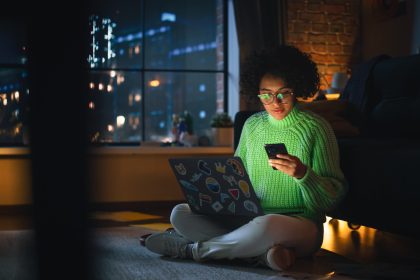In our increasingly digital world, we’re surrounded by blue light sources from the moment we wake up until we finally put down our phones at night. This high-energy light radiates from our smartphones, computer screens, tablets, LED lighting, and even the sun—which remains by far our most significant source of blue light exposure, outshining our devices by a factor of 100,000 on a sunny day.
As screen time continues increasing across all age groups, concerns about potential eye damage have sparked debates among health professionals and generated a multimillion-dollar market for protective products. But separating fact from fiction about blue light proves crucial for making informed decisions about your eye health.
Understanding how blue light affects not just your vision but also your sleep patterns, mood, and overall wellbeing provides valuable context for developing healthy habits in our screen-dominated world. With digital devices now essential to modern life, learning to manage blue light exposure represents an important health strategy rather than something to fear or ignore.
How blue light impacts your eyes
Blue light exists on the color spectrum with some of the shortest wavelengths and highest energy. This distinctive property explains both its beneficial and potentially problematic effects on the human body, particularly the eyes.
The front structures of the eye—the cornea and lens—block most UV light from reaching the retina. However, blue light passes through these protective barriers almost completely unfiltered, reaching the delicate light-sensitive cells at the back of the eye. This direct exposure raises questions about potential cumulative damage over time.
While natural blue light from the sun has always been part of human experience, our relationship with artificial blue light sources has changed dramatically. The average American now spends over seven hours daily looking at screens, creating unprecedented levels of artificial blue light exposure directly in our line of vision, often at close range.
Research continues examining whether this extended screen exposure contributes to permanent eye damage. Most current evidence indicates that the intensity of blue light from digital devices remains too low for immediate serious harm. However, the extended duration of exposure creates conditions never before studied across large populations.
What remains clearer are the short-term effects many experience during and after extended screen time. Digital eye strain—characterized by dry, irritated eyes, blurred vision, and difficulty focusing—affects approximately 65% of Americans who spend hours looking at screens. While not permanently damaging, these symptoms can significantly impact comfort, productivity, and quality of life.
Early laboratory studies suggest potential concerns regarding retinal cells, which detect light and transmit visual information to the brain. Some research indicates blue light may accelerate cellular aging in these highly specialized cells, potentially contributing to age-related macular degeneration—a leading cause of vision loss. However, these findings remain preliminary and require additional research to determine real-world implications.
For most people, the primary eye-related impact from blue light comes from the suppression of the blinking reflex during screen use. We typically blink about 15 times per minute, but this rate drops by half when focusing on digital screens. This reduced blinking leads to increased tear evaporation and contributes to dry eye symptoms that many screen users experience.
Beyond vision: How blue light disrupts your sleep
While the debate continues regarding blue light’s direct impact on eye health, its effect on sleep is much more firmly established. Blue wavelengths powerfully suppress melatonin—the hormone responsible for regulating sleep cycles—more than any other light type.
This biological response served humans well throughout evolution, helping maintain alertness during daylight hours. However, exposure to blue light from screens in the evening creates confusion in these ancient biological systems, essentially sending signals that the sun remains high in the sky even as bedtime approaches.
Studies demonstrate that using blue-light emitting devices before bed can delay sleep onset by approximately 30 minutes compared to reading printed materials. Beyond taking longer to fall asleep, blue light exposure can reduce time spent in critical REM sleep phases and decrease overall sleep quality.
These sleep disruptions create a cascade of effects beyond just feeling tired. Chronic sleep insufficiency links to serious health consequences including increased risk of obesity, diabetes, cardiovascular problems, and depression. For many people, managing blue light exposure, particularly in evening hours, provides an effective strategy for improving sleep quality.
Interestingly, this same alertness-boosting effect offers benefits in appropriate contexts. Morning exposure to blue light helps establish healthy circadian rhythms and can enhance daytime alertness, cognitive function, and mood. Athletes sometimes use controlled blue light exposure to improve reaction times and decision-making abilities before competition.
The connection between blue light and mood
Beyond sleep cycles, blue light directly influences mood regulation through specific light-sensitive cells in the retina that connect to brain regions controlling emotions. These specialized photoreceptors respond particularly strongly to blue wavelengths, explaining why daylight exposure so powerfully affects psychological wellbeing.
This relationship explains the effectiveness of light therapy for seasonal affective disorder (SAD)—a type of depression occurring during winter months when natural sunlight diminishes. Controlled exposure to bright light, particularly with blue wavelength components, can significantly improve mood and energy levels for those experiencing seasonal depression.
The mood-boosting properties of blue light during daylight hours contrast with its potentially disruptive effects in the evening, highlighting the importance of timing. Morning exposure to blue light typically benefits mood and alertness, while evening exposure may interfere with the natural transition to restfulness and sleep.
This complex relationship with blue light reflects our evolutionary history spent synchronized with natural daylight patterns. Our bodies evolved sophisticated responses to the sun’s daily cycle, with blue morning light triggering alertness and the absence of blue light in evening hours signaling time for rest and recovery.
Practical strategies for healthy blue light management
Rather than avoiding digital devices entirely, implementing targeted strategies helps minimize potential negative effects while maintaining the benefits of our connected world:
Follow the 20-20-20 rule during extended screen sessions. Every 20 minutes, look at something 20 feet away for at least 20 seconds. This simple practice helps reset your blinking pattern, reduces eye muscle fatigue, and gives tears a chance to relubricate the eye surface. Setting a timer provides helpful reminders until this habit becomes automatic.
Adjust device display settings to reduce blue light emission, particularly in evening hours. Most smartphones, tablets, and computers now include “night mode” or “night shift” features that automatically warm screen colors by reducing blue wavelengths after sunset. These settings maintain screen visibility while significantly reducing blue light exposure.
Consider specialized computer glasses with slight magnification and anti-reflective coatings for extended screen work. These glasses reduce glare and optimize focus at typical screen distances, potentially decreasing eye strain during long digital sessions. Some versions include slight yellow tinting that selectively filters blue light while maintaining color perception for most tasks.
Position screens appropriately to minimize strain. Computer monitors should sit approximately arm’s length away (20-24 inches) and positioned so your gaze falls slightly downward when looking at the center of the screen. This position creates less demand on focusing muscles and reduces the exposed eye surface area, decreasing dryness.
Create a “digital sunset” routine by avoiding screens for 1-2 hours before bedtime. When evening screen use proves unavoidable, maximize blue light reduction features and consider using red-based lighting for surrounding areas, as red wavelengths have minimal impact on melatonin production.
Maintain proper lighting throughout your workspace and living areas. Position lights to minimize glare on screens, and consider bulb temperature for different settings. Cooler blue-toned lighting enhances alertness for task-oriented spaces, while warmer lighting creates relaxing environments appropriate for evening hours.
Take regular movement breaks that include looking into the distance. Brief walks, even indoors, provide opportunities to shift visual focus and counteract the effects of sustained near work. These breaks benefit both eye health and overall physical wellbeing during extended desk sessions.
Protecting long-term eye health beyond blue light
While managing blue light exposure represents one aspect of eye care, comprehensive protection includes additional important strategies:
Schedule regular comprehensive eye examinations, even if you have no obvious vision problems. Many serious eye conditions develop without early symptoms, yet respond best to treatment when detected early. For most adults, examinations every 1-2 years provide appropriate surveillance, though your eye care professional may recommend different intervals based on your specific risk factors.
Protect your eyes from ultraviolet (UV) radiation by wearing sunglasses that block 100% of UVA and UVB rays. Unlike blue light, UV radiation definitively causes cumulative damage to eye tissues, potentially contributing to cataracts and other conditions. Wear protective eyewear even on cloudy days, as UV rays penetrate cloud cover.
Nourish your eyes through diet by consuming foods rich in nutrients supporting eye health. Dark leafy greens provide lutein and zeaxanthin, which concentrate in the retina and may help filter harmful light. Fatty fish offers omega-3 fatty acids that maintain healthy tear production and reduce inflammation. Colorful fruits and vegetables supply various antioxidants that support overall eye health.
Stay adequately hydrated to support proper tear production. Dehydration often worsens dry eye symptoms, particularly during extended screen use when blinking decreases. Keep water accessible during screen sessions as a reminder to maintain hydration throughout the day.
Manage chronic health conditions like diabetes and hypertension that can damage the eye’s delicate blood vessels over time. Following treatment plans for these conditions protects not only overall health but also preserves vision by preventing complications affecting the retina and other eye structures.
Consider your overall screen habits beyond just blue light exposure. The increasing prevalence of digital eye strain relates not only to light wavelengths but also to the demanding visual nature of screen work itself. Even with perfect blue light management, excessive screen time creates visual and mental fatigue that benefits from regular breaks and non-digital activities.
Finding the right balance with blue light
Understanding blue light’s complex effects allows for nuanced approaches rather than extreme positions. Neither avoiding all blue light exposure nor ignoring its potential impacts represents an optimal strategy for most people.
Morning and early afternoon blue light exposure generally benefits alertness, mood, and healthy circadian rhythms. During these hours, concerns about blue light should focus primarily on reducing digital eye strain through proper screen positioning, regular breaks, and blinking awareness rather than eliminating blue light entirely.
Evening hours call for more aggressive blue light management as biological systems prepare for sleep. Reducing screen time, maximizing device night settings, and creating lighting environments with minimal blue components help maintain natural melatonin production for quality sleep.
By approaching blue light management with this time-based perspective, you can maintain the benefits of our digital world while minimizing potential negative consequences. Rather than fearing blue light, understanding its effects empowers you to create environments and habits supporting both productivity and health in our screen-centric age.

















